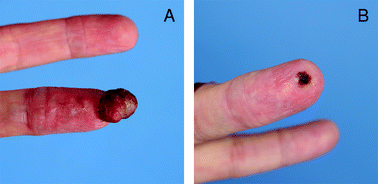A potassium-titanyl-phosphate laser is an efficacious tool in the treatment of pyogenic granulomas. A retrospective study in 28 patients
Abstract
Background and objective: Pyogenic granuloma is a common benign vascular lesion of the skin and mucosa prone to ulceration and bleeding. Current therapeutic approaches include surgical excision, removal by means of electro caustic therapy, cryotherapy, and ablation with CO2 or vascular lasers. The purpose of this study was to investigate the efficacy of a 532 nm potassium-titanyl-phosphate laser (KTP-laser) for the treatment of pyogenic granulomas in terms of efficacy, advantages in clinical outcome, technique and associated side effects. Methods: In this retrospective study we report on the response of 28 consecutive patients with pyogenic granulomas at multiple locations on the skin after having been treated with a 532 nm KTP laser (532 nm AuraTM Star Pulse laser, Laserscope, CA, USA). Treatment was performed with a 2 mm handpiece and energy fluences of 35–60 J cm−2 and a laser pulse width of 50 ms or with a 1 mm handpiece and energy fluences of 200–240 J cm−2 and a laser pulse width of 50 ms. All patients were treated on an outpatient basis at the department of dermatology, Medical University of Vienna, Austria. Results: In all of the 28 patients treated, we were able to demonstrate both symptomatic and clinical clearing of the lesions with excellent cosmetic results after the treatment. In 25 of the 28 patients a single treatment was sufficient to obtain optimal results. In three patients a second treatment session was required due to the recurrence of the lesion. The procedure required only local anesthesia, and postoperative care was limited to the application of a topical antibiotic ointment. No postoperative complications such as increased pain or wound infection and only minimal scarring were observed. Conclusions: This experience with excellent patient satisfaction suggests that treatment of pyogenic granulomas with the KTP laser is a safe, effective, and reasonable alternative to conventional therapy. As with many other limited interventions with this laser technology, the advantages include minimal postoperative pain, conservative site-specific minimally invasive surgeries and a very satisfactory cosmetic result with a high acceptance rate on the side of the patients.

- This article is part of the themed collection: Lasers in medicine


 Please wait while we load your content...
Please wait while we load your content...